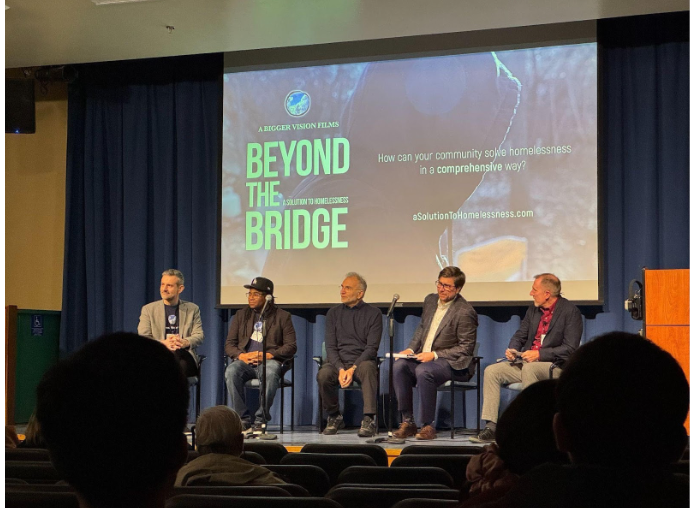News Date:
Content:
Homelessness is a complex crisis that Don Sawyer and Tim Hashko travelled over 40,000 miles across the United States to find answers to.
Sawyer and Hashko are filmmakers who created “Beyond the Bridge: A Solution to Homelessness.” They stopped by UC Santa Barbara for a screening of their documentary followed by a conversation about the misconceptions surrounding homelessness and how to address them. The solutions: affordable housing and supportive services.
“We as a country do not have to put up with homelessness,” Hashko said in the documentary. “There’s a blueprint to solve it.”
Hashko said there is a blueprint for change, the federally funded Housing First program, which focuses on long term affordable housing that comes with support programs. Now, Sawyer and Hashko are spreading the word about their findings in communities across 40 different cities. Their campaign seeks to change the discourse about homelessness across the country. Each screening is followed by a Q&A with the filmmakers and leading community members.
At UCSB, filmmakers Sawyer and Hashko shared a stage with the founder of the Housing First model, Sam Tsemberis, who sees housing as a basic human right along with mental support services for those in need. Joining them was Will Cooper, CEO of Cooper Housing Institute, a private foundation built to end the housing crisis in America. Also on the panel was UCSB Political Science and Geography professor Clayton Nall, who provided insight on the local policy landscape.
A major focus for the filmmakers was the theme of collaboration. In order to successfully implement a program that works, different communities — policy makers, law enforcement, service providers, and the like — must come together to discuss the complex issues they face and work towards an efficient solution.
The film also features first-hand interviews with people experiencing homelessness, such as Nicole, who found herself sleeping in her car due to lack of employment and family support. Her story, like many others, was improved by the Housing First Initiative policies.
This is Sawyer and Hashko’s second film project focused on homelessness, having first focused on the causes of homelessness. The current film, they said, acts as an extension of their previous work, applying their findings towards a successful solution for people like Nicole.
“We say, this is who needs to be on the panel to bring that message forward and get that progress,” said Sawyer. “Then we ask, what do we want people to do the next day?”
Sawyer said he and Hashko are selective in their panel participants, choosing those who focus on takeaways and practical goals. Hashko calls it “magical” when a panel discusses the film in a productive way. It becomes the first step towards actionable change, planting the seeds towards something bigger than the film, he said.
The filmmakers recounted their experience in Milwaukee, which spurred the “journey of our lives.”It became one of the most successful cities to implement Housing First because of the local government’s willingness to find a lasting solution.
“Milwaukee’s government officials had a system where they had set goals with numbers and targets, and they were accountable to each other and were also very public about the results,” Sawyer said.
But the panelists pointed out that coastal California proves more challenging. A shortage of housing in the state is an ongoing problem and there are regulatory obstacles that have proven difficult to overcome.
“Regulatory obstacles that are in the way, are meant to solve other problems that we also care about, but they end up just layering on a bunch of obstacles to building more housing for people,” non-profit leader Cooper said. He cited environmental regulations that protect open spaces as one example of these obstacles.
Sawyer concluded his message by emphasizing that having “movers and shakers on board” makes it easier to get things done, allowing more and more people to get affordable housing and the care that they need to succeed.
Sawyer and Hashko will continue their tour into late 2025, spreading their findings and sparking meaningful conversations in communities around the United States.

Pictured from left to right: Filmmakers Tim Hashko and Don Sawyer with Sam Tsemberis, Clayton Nall, and Will Cooper, on a recent panel at UC Santa Barbara.
Ava Miya Jewett is a third-year Communication major. She wrote this piece for her Digital Journalism class.






